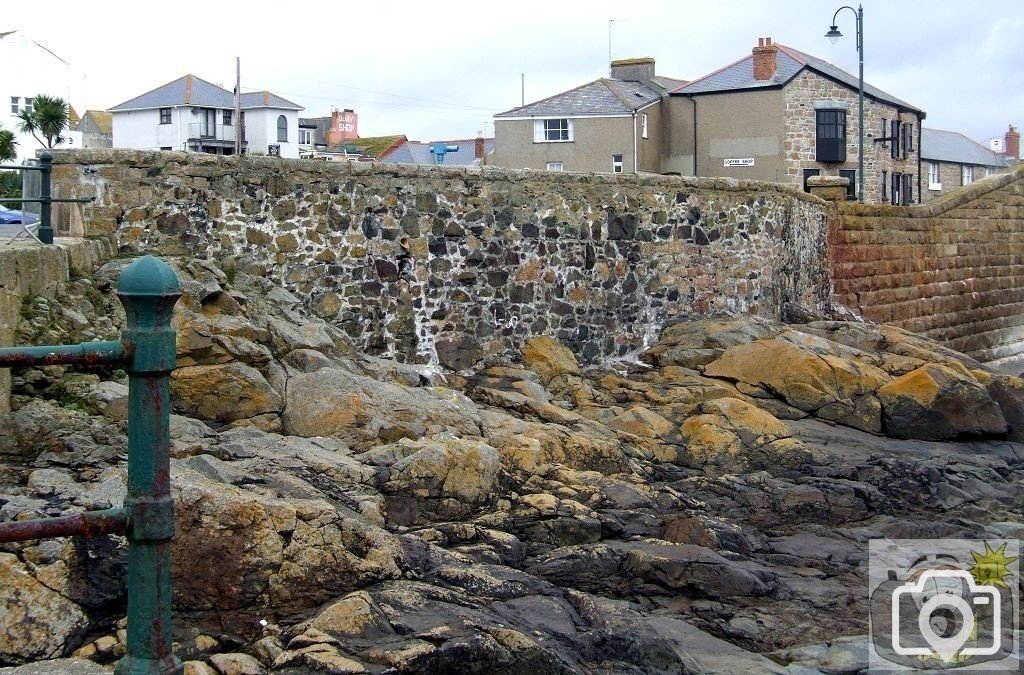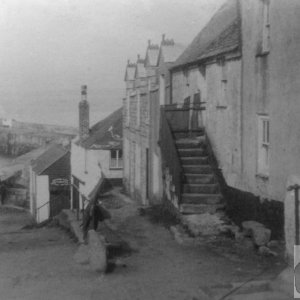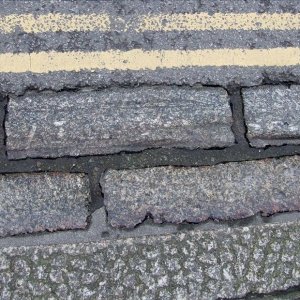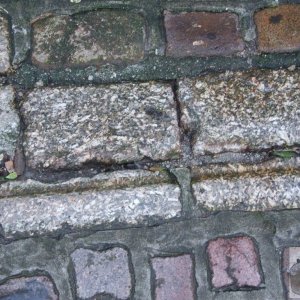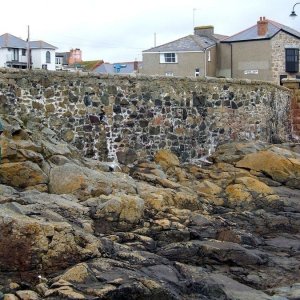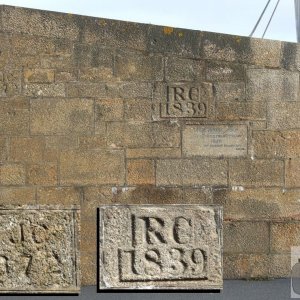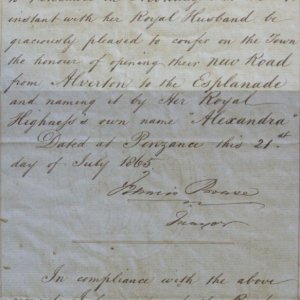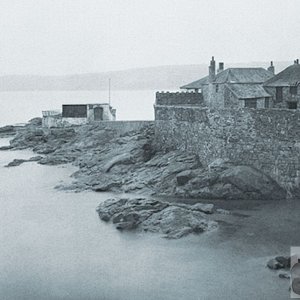You are using an out of date browser. It may not display this or other websites correctly.
You should upgrade or use an alternative browser.
You should upgrade or use an alternative browser.
To the left is the old wall, clearly divided into base and the re-built top; the lower wall is as in the photograph of 1915. It is the wall as built prior to 1720, as the 1839 wall was built on top of that level, and the access to the paving of 1740 is shown on the 1915 photo, and has not been changed from that of 1740, it is still there. The level of the access to the battery had to be between the Kiln yard and the tenement courts, as shown on the OS of 1875, and as shown on the 1842 Tithe Map. Boundaries were defined by ownership and inheritance, the route to the battery would have been sacresanct. It is also clear that this wall was a part of the munpit of before 1720, I therefore suggest that it is a part of the original barbican defence wall of the town and quay. If only as the stone of which is is made. To the right is the wall of 1923, 'new' faced, yet the inside is of re-used original cut stone of 1839, on its new alignment.
Barbican
Was there a Fort or Castle on The Barbican?
Henry the VIII after having a tiff with Catherine of Aragon, felt a little insecure and ordered a series of Device and Artillery Forts to be built along the coast at Ports; from about 1536-1542.
When looking at these forts, today, it is clear that they are masterful pieces of architecture, masonry and military defence.
Henry did not 'mess around'.
There has been rumour as to Henry VIII having ordered the construction of a fort at Penzance, which most likely appears to be a promoted misunderstanding. There are no reports of such a fortification or any records of such, which is unlikely if there were as such.
John Leland in 1538 states that there was but a pier at Penzance, offering no shelter.
Henry VIII declared a grant in 1512 for harbour dues, in which ensured the responsibility for the quay and bulwarks lay on the townspeople, and makes no mention of any castle or fortification, let alone an instuction to build one.
Surveyor of The Duchy of Cornwall was John Norden, and in 1604 reports that Penzance was the head of the sand, and was of late very much defaced, being also burned by the Spaniards in 1595 (just two years before John Leland visited Penzance); he makes clear mention of castles in other town reports.
If there had been a fort at Penzance, it may well, if not probably have made a large difference to the result of the 'Spangers' making their firey entrance.
Sir Francis Godolphin was accompanied by the Cornish Militia (briefly before they caught sight of the Spaniards); it is reported that a prize cannon was removed with great effort and ceremony from the battery by the Spaniards. This could prove that there was a battery on the headland in 1595.
No other military fort or castle, or militia accommodation is noted until later, however, in George Daniel's effects it clearly states that his property was at Barbican Cellars.
I believe this to relate to the defensive 'earthworks' or 'stone walls' surrounding the seafront at the pier and battery, The Battery proper not being constructed until 1740 at the expense of the townspeople.
P.A.S. Pool has transcribed Henry VIII's Grant ... 'reparacion of our key and bulleworks' and the text describes that they already exist.
I doubt bulwarks in the sense shown means any different then, from its present meaning, a defence wall of earth or stone, to protect the pier and ships from the effects of the sea.
In 1729 forced by the actions of the tinner riots, soldiers were sent to Penzance and they were billetted, which rather points to the fact that there were no facilities for soldiers to be sent into a fort or barbican quarters.
Penzance sent out a 'petition for great guns' in 1739 to which the reply was that it would be honoured if the Corporation built a battery; if a battery and/or barbican had previously existed, there would have been little point in this plea and expense of £200.
Much has been said that nothing remains of the old battery, but close inspection of the stonework under the walls of the war memorial reveal that the base is still there, and it follows the line of the OS map layout and photographs of the battery before it was changed.
At this point it will be added that the cellars and stores in the position now occupied by the Barbican buildings was named the Barbican before 1720. Barbican meant the outer defence of the town or city, usually at the entrance or defensive gateway. It seems likely therefore that the name of this area referred to the sea walls at which soldiers were stationed to protect the town at the quays, rather than a specific building erected for the defence of the townsfolk.
Battery Rocks gained its name in 1740.
In view of their directive as to the production of a history and account of the people and their lands, I find it surprising that neither Carew nor Norden make mention of a fort at Penzance, considering just who was is supposed to have ordered its construction.
Carew notes as to found copper swords and battleaxes, making no surprise as to their presence, being fully aware of early history.
He also makes great account of the late Spanish attack by 200 men upon the town.
At one point they returned and re-anchored further out in the Bay.
Then returning to shore with 400 men and marched on Penzance.
The attack on their ships was taken up later with arrows, and bullets; the ships thus moved off further.
The defeat of the attack (with the resolve and bravery of the men of Penzance - and certainly not the Cornish Militia) was the arrival of a small English flotilla at Lizard Head and the providential change in the wind.
There is no mention of any attack from a fort or battery by cannon fire, the ships and complement would not have stood a chance against the splintering timbers.
Carew makes no mention of the prized cannon. An oversight? Or an excess by Sir Francis Godolphin? Who knows.
The distance that the Spanish were anchored offshore is identified by the fact that the ships were being struck by arrows, not by bowmen, but by townsfolk. The soldiers were at the Eastern Green. In 1590, Sir Roger Williams wrote: 'few or none archers do anie great hurt 12 or 14 score (20 yards) off - that is 840 feet. Top longbow archers of the attack on Agincourt shot 1200 feet, yet in 1590 it was barely 750 feet as shot by an experienced bowman, who certainly knew how to catch the family dinner. Sir Roger was not happy at his bowmen being less accomplished than either Henry V's men or that much better than local farmers. The Spanish were therefore some 700 feet offshore, and easy target for a cannon, and the Spanish would have known that if there was a cannon firing or present, they certainly would not have anchored so close to shore.
Raymond Forward
Barbican
Was there a Fort or Castle on The Barbican?
Henry the VIII after having a tiff with Catherine of Aragon, felt a little insecure and ordered a series of Device and Artillery Forts to be built along the coast at Ports; from about 1536-1542.
When looking at these forts, today, it is clear that they are masterful pieces of architecture, masonry and military defence.
Henry did not 'mess around'.
There has been rumour as to Henry VIII having ordered the construction of a fort at Penzance, which most likely appears to be a promoted misunderstanding. There are no reports of such a fortification or any records of such, which is unlikely if there were as such.
John Leland in 1538 states that there was but a pier at Penzance, offering no shelter.
Henry VIII declared a grant in 1512 for harbour dues, in which ensured the responsibility for the quay and bulwarks lay on the townspeople, and makes no mention of any castle or fortification, let alone an instuction to build one.
Surveyor of The Duchy of Cornwall was John Norden, and in 1604 reports that Penzance was the head of the sand, and was of late very much defaced, being also burned by the Spaniards in 1595 (just two years before John Leland visited Penzance); he makes clear mention of castles in other town reports.
If there had been a fort at Penzance, it may well, if not probably have made a large difference to the result of the 'Spangers' making their firey entrance.
Sir Francis Godolphin was accompanied by the Cornish Militia (briefly before they caught sight of the Spaniards); it is reported that a prize cannon was removed with great effort and ceremony from the battery by the Spaniards. This could prove that there was a battery on the headland in 1595.
No other military fort or castle, or militia accommodation is noted until later, however, in George Daniel's effects it clearly states that his property was at Barbican Cellars.
I believe this to relate to the defensive 'earthworks' or 'stone walls' surrounding the seafront at the pier and battery, The Battery proper not being constructed until 1740 at the expense of the townspeople.
P.A.S. Pool has transcribed Henry VIII's Grant ... 'reparacion of our key and bulleworks' and the text describes that they already exist.
I doubt bulwarks in the sense shown means any different then, from its present meaning, a defence wall of earth or stone, to protect the pier and ships from the effects of the sea.
In 1729 forced by the actions of the tinner riots, soldiers were sent to Penzance and they were billetted, which rather points to the fact that there were no facilities for soldiers to be sent into a fort or barbican quarters.
Penzance sent out a 'petition for great guns' in 1739 to which the reply was that it would be honoured if the Corporation built a battery; if a battery and/or barbican had previously existed, there would have been little point in this plea and expense of £200.
Much has been said that nothing remains of the old battery, but close inspection of the stonework under the walls of the war memorial reveal that the base is still there, and it follows the line of the OS map layout and photographs of the battery before it was changed.
At this point it will be added that the cellars and stores in the position now occupied by the Barbican buildings was named the Barbican before 1720. Barbican meant the outer defence of the town or city, usually at the entrance or defensive gateway. It seems likely therefore that the name of this area referred to the sea walls at which soldiers were stationed to protect the town at the quays, rather than a specific building erected for the defence of the townsfolk.
Battery Rocks gained its name in 1740.
In view of their directive as to the production of a history and account of the people and their lands, I find it surprising that neither Carew nor Norden make mention of a fort at Penzance, considering just who was is supposed to have ordered its construction.
Carew notes as to found copper swords and battleaxes, making no surprise as to their presence, being fully aware of early history.
He also makes great account of the late Spanish attack by 200 men upon the town.
At one point they returned and re-anchored further out in the Bay.
Then returning to shore with 400 men and marched on Penzance.
The attack on their ships was taken up later with arrows, and bullets; the ships thus moved off further.
The defeat of the attack (with the resolve and bravery of the men of Penzance - and certainly not the Cornish Militia) was the arrival of a small English flotilla at Lizard Head and the providential change in the wind.
There is no mention of any attack from a fort or battery by cannon fire, the ships and complement would not have stood a chance against the splintering timbers.
Carew makes no mention of the prized cannon. An oversight? Or an excess by Sir Francis Godolphin? Who knows.
The distance that the Spanish were anchored offshore is identified by the fact that the ships were being struck by arrows, not by bowmen, but by townsfolk. The soldiers were at the Eastern Green. In 1590, Sir Roger Williams wrote: 'few or none archers do anie great hurt 12 or 14 score (20 yards) off - that is 840 feet. Top longbow archers of the attack on Agincourt shot 1200 feet, yet in 1590 it was barely 750 feet as shot by an experienced bowman, who certainly knew how to catch the family dinner. Sir Roger was not happy at his bowmen being less accomplished than either Henry V's men or that much better than local farmers. The Spanish were therefore some 700 feet offshore, and easy target for a cannon, and the Spanish would have known that if there was a cannon firing or present, they certainly would not have anchored so close to shore.
Raymond Forward

